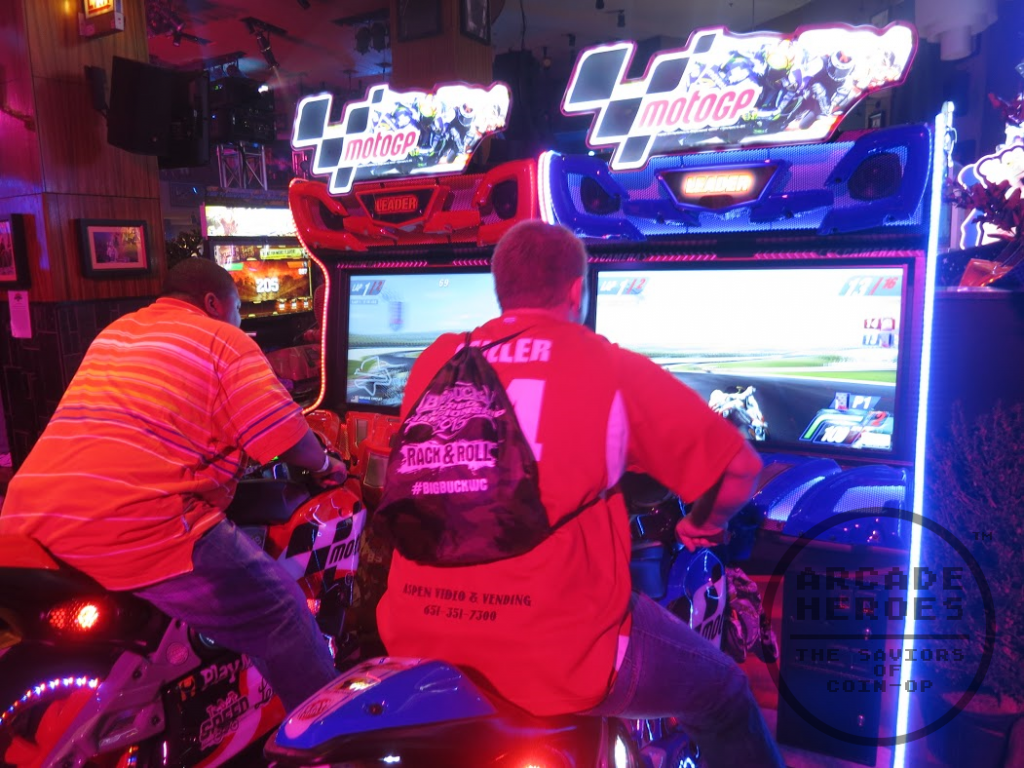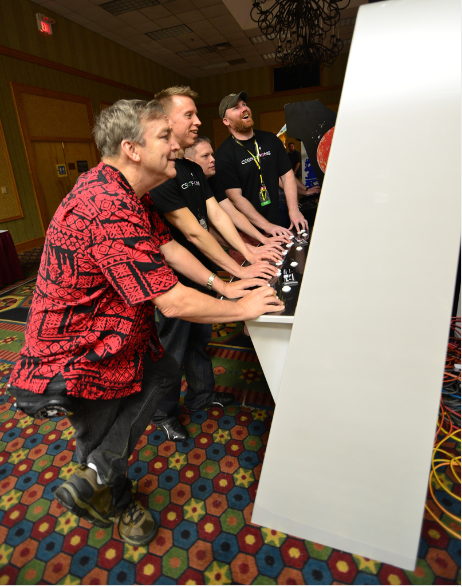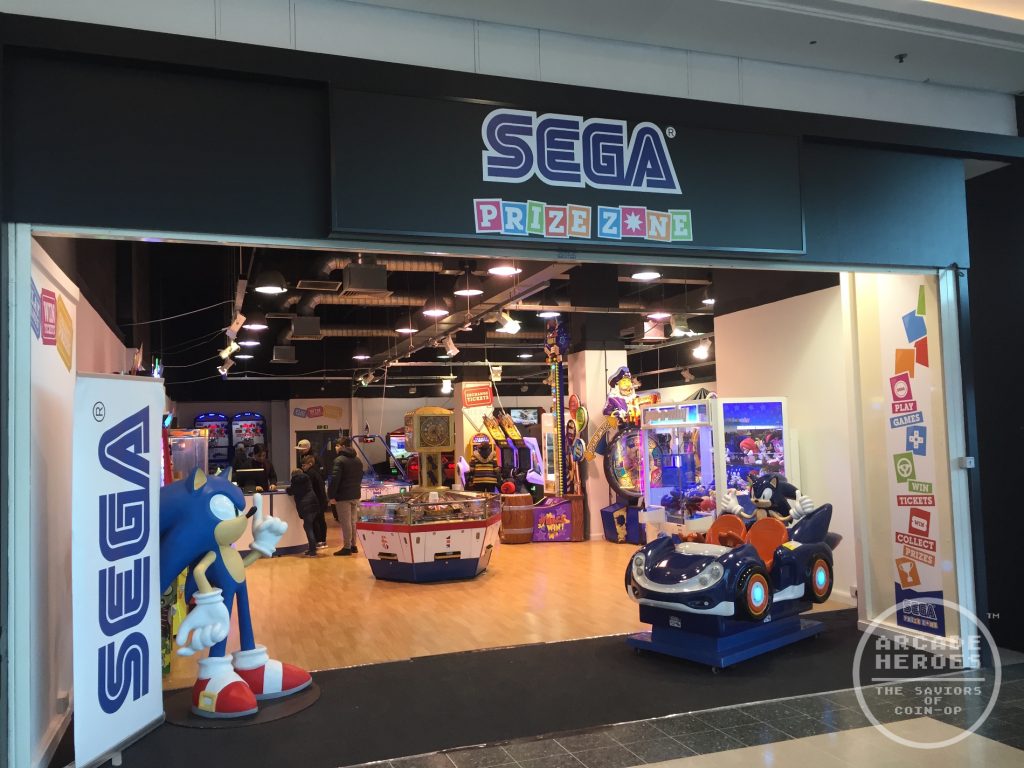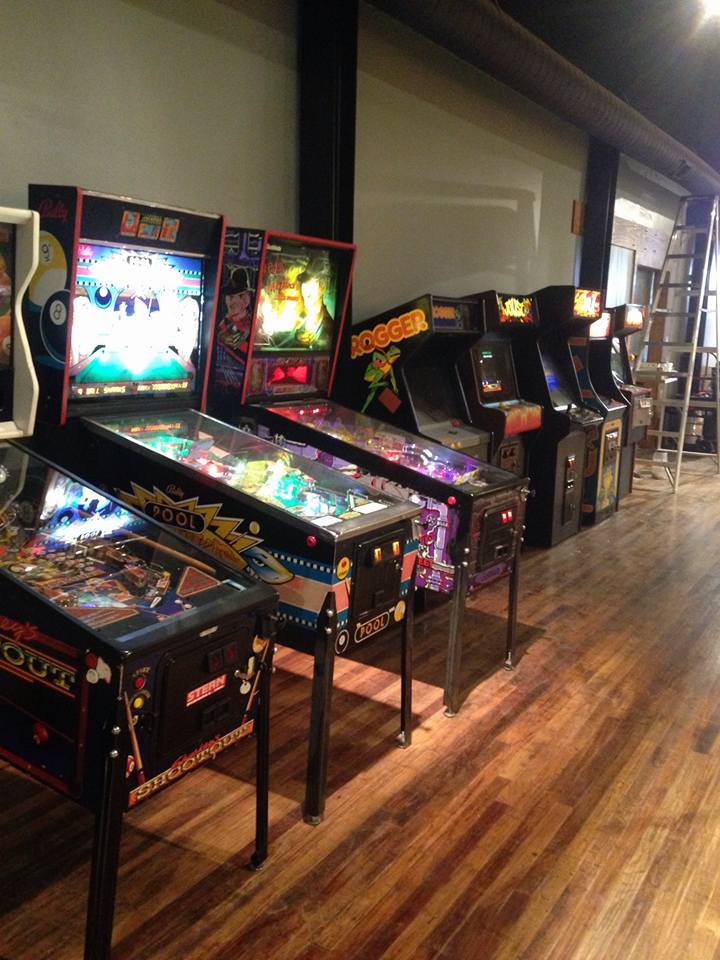 The Good News!
The Good News!
Why Arcades Haven’t Died In the U.S. (& How They’re Very Much Alive)
by Adam Pratt, Game Grid Arcade & ArcadeHeroes.com
This month’s op-ed is based on an article that I wrote for my Arcade Heroes blog back in February. It was created in response to an article that ran on a popular gaming news site known as Kotaku. That article was entitled “Why Arcades Haven’t Died in Japan” and offered up that writer’s perspective as to why the arcade business and culture has remained strong despite diminishing in size.
The Kotaku article did do a fine job at pointing out what it is that Japanese arcades do to stay in business, but it neglected to point out the very real growth that the business has seen in the U.S. (The burgeoning FEC business is a prime example, as well as other other types of game rooms from retrocades and game “museums” to bar arcades and beyond, but we’ll get into that later.) As I have discovered over the years both as a member of the press and as an operator, mainstream gaming media keeps the U.S. arcade business out of sight and thus out of mind. There are some exceptions. Stern Pinball is frequently using sites like IGN to promote their new releases, but on the whole, you rarely see a piece hyping up the latest new arcade title to land on the market on those outlets.
I have responded to the tired old mantra “ARCADES ARE DEAD” more times than I can count. It may seem futile to try to counter it every time a game site tries to impart their armchair-quarterback wisdom onto their readers. However, this is how I now make my living and my family depends on the success of the arcade. That wasn’t always the case. I’ve worked several jobs outside of the amusement business and for the first few years, the arcade barely made enough to pay its own bills. Now that my Game Grid Arcade has been open for nine years, that is a different story.
If you’ve been around since the ’80s, you’ve seen changes in virtually every aspect of the business. Many locations have closed their doors, but such closures in any business often happen for various reasons. I don’t have the space to get into all of the things that can go right or wrong, but suffice it to say, I don’t assume that if a location closes that it’s the primary fault of the games inside or the fact that it’s a game room. If people aren’t coming to an arcade to play, that’s the fault of the management, either from poor game selection, failure to maintain the equipment in top condition or in finding the best location, etc.
Now why should I bother to write about this subject for RePlay? I have heard plenty of pessism about the amusement business from within the sector. “We can never compete with <insert the new home game console of your choice here>!” or “We can never compete with phones!”
Except that we can and do. So let’s get into some bullet points regarding the situation and go from there.
You’re Not Alone: Over 160,000 U.S. Locations Have Arcade Games
The second paragraph of the Kotaku article does use some data to show that the size of the arcade business in Japan has shrunk from its heyday in the mid-1980s. That is not to show that the scene has vanished in Japan, but to illustrate that they are, in fact, still around. I’ve come across an assumptive notion that operates like an unwritten law – that the business must surpass the size and scope of what the scene was like in 1982, otherwise it’s “dead.” Silly!
If Japan’s scene isn’t dead because it still has locations, then the same should apply to the U.S. market, too. If you do some digging into published numbers, you’ll find there are approximately 166,760 locations that contain or operate arcade equipment.
Seems that I’m not the only one putting food on the table thanks to these kinds of machines.
A huge bulk of that number comes from street locations, but 2,500 of them are classified as “arcades” (like mine) with 3,500 coming from the pool of FECs. FEC chains have been growing rapidly in recent years as have “arcade bars.” Tracking new openings is a difficult task because many locations are local establishments that do not directly benefit from having national or worldwide coverage on their locations. That said, amusement news outlets like RePlay do report about new locations through the email newsletter when we do know about them. Just remember that because the big consumer gaming news sites with their millions in ad revenues never mentions them doesn’t mean that there isn’t growth.
Aurcade.com tracks locations based on user input. Companies like Bandai Namco have created game trackers so players can find where certain machines are located. And to quote one of those annoying clickbait articles, “the results will shock you,” at least when you’ve been told repeatedly over the years that “arcades” no longer exist.

Dozens of New Games Are Released for the U.S. Market Every Year
Rhetorical question: Why would anyone bother to spend the money it takes to create an arcade title if there’s no market of buyers to sell it to?
It is true that video arcades do not see quite as many releases now as they did in 1982 by a large factor, but games –– and really good ones –– are still made. Expand game offerings to redemption, video redemption and pinball, and the numbers are higher.
Now I understand that a dozen titles or so isn’t very impressive when you look at digital distribution systems like Steam, iTunes, Google Play Store, PSN, XBL, eShop, etc., where hundreds and hundreds of games are released every year. Keep in mind that developers for those titles do not have to develop their own hardware (cabinet, controllers, display, sound system, PC and artwork) nor deal with the challenges that such a thing entails (distribution, tech support, parts and warranty). Those variables makes a big difference.
Pinball in particular has been experiencing growth and you can now buy new games not just from Stern, but also Jersey Jack, Heighway, Spooky and some others. If it’s an “obsolete” form of entertainment, then I guess everyone employed by these companies didn’t get the memo.
These aren’t sold just to businesses in the industry either. I was often surprised by certain equipment I sold to homes: Golden Tee, anything Pac-Man, Big Buck and basketball arcade machines were requested for homes at any time of the year. The frequency of home sales of basketball machines was a real surprise.
Millions of dollars are spent creating and building these games because the people making them expect to make that investment back and then some. Jurassic Park Arcade (2015) had a budget of around $4 million. Other high end games like Star Wars Battle Pod certainly didn’t cost a mere few thousand dollars to “throw together.”
The Kotaku article mentions that there are new releases for Japanese arcade players to enjoy – the same applies here. RePlay and others cover new releases from the video arcade to redemption markets when there is pertinent news to share. Just because mainstream gaming journalists ignore anything without a license doesn’t mean that it no longer exists.
It is worth noting that the numbers of new coin-op releases in the States and those in Japan are not much different from each other. Last year, the U.S. market had 15 video only and pinball releases while the Japanese market only had 18. (The U.S is higher when you take video redemption and redemption into account.)
You would think that if the Japanese market was so massively strong as to not be considered “dead” like Kotaku says that it would have a significantly higher number of releases than the U.S. The reality is that they are pretty much neck and neck with each other.

Game Makers Understand Trends for the U.S. & Focus on Exclusive Experiences
Generally speaking, Japanese gamers have certain tastes that are not shared by all of their American counterparts and vice versa. Thus, not all games sell on both markets. Round1 USA and Dave & Buster’s have tested or placed various Japanese games on location, but so far, not much of that content has managed to capture the investment dollars of other locations. You’ve had Mario & Sonic Olympics or Luigi’s Mansion Arcade find their way into general distribution, but if you’re hoping to find Gunslinger Stratos 3, Silent Scope: Bone Eater or Dariusburst Another Chronicle outside of Japan, you’re likely to be disappointed.
Likewise, if the Japanese arcade goer is looking for the latest Golden Tee, then good luck on that quest.
The Kotaku article mentioned how Japanese arcades respond to demographic trends. American venues do the same, but it’s just with a different mix of games. If you go to an arcade and its game selection is 80 percent redemption and 20 perent video, that’s probably because the customer base responds to that mixture of games, catering to kids and families. You don’t see much redemption at bar/arcades because those spots cater to an older crowd. Either way, the business is responding to trends and giving their customers what they want.
That’s also why we’ve seen an increase in video redemption games, along with the existence of companies who almost exclusively produce video redemption content. They wouldn’t be around if there was no market for them to sell to. Whether we like it or not, that’s also why so many facilities have a large number of redemption games. That’s what the younger market often wants to play and it is what they have come to expect.
In running a video arcade with no tickets, no alcohol and in a mall, I still encounter people in the industry who don’t believe me when I tell them that I’ve been successful at doing so. I see parents walking around with newborn babies while a 70-year-old man plays some pinball. Covering all demographics isn’t hard as long as you carefully pick your game mix.
Now we can certainly have a debate about the quality of games. Many titles these days don’t demand much skill from the player. Personally, I find that unfortunate, but I understand that gaming culture, especially with the casual player, isn’t exactly the same as it used to be. (But that is a subject for a different article.)
That’s why we’ve seen a focus on racing and light-gun games for such a long time on the video side. Those titles can make their cost back in a relatively short time. If it’s taking a game three or more years to pay itself off, you can bet that the next purchase that an operator makes is one that will be paid off in less than a year. But even outside of video games, arcades can still offer a varied line-up of entertainment that appeals to their customers.

Game Makers & Operations
The Kotaku article does make a valid point about the business culture for many game developers. World famous game creators like Shigeru Miyamoto got his start specifically designing games for arcade use, but his focus has been on home entertainment for many years since. For those thousands of developers out there making games for home devices (consoles or mobile), they either don’t have an arcade background or are not creating any title with the arcade market in mind. The weird thing about the arcade business is that you essentially have two buyers: 1) the operator who pays $7,000+ for the game and 2) that operator’s customers who might be paying $1 a pop per game. This requires a different philosophy on how a commercial, coin-op game should work versus one for the home environment.
The article also gets into how many companies have site operations. Sega, Taito, Capcom and other branded arcades are a very common part of the Japanese location landscape and that is a bit different from what we see here, although in Japan, these tend to be divisions within a much larger company.
Companies like Namco have an entire division dedicated to either operations or a facility in the United States. Level 257 in Illinois is a prominent one. Sega used to have Gameworks, which now operates independently, but over in the U.K. we saw the recent opening of two Sega-branded “Prize Zone” locations.
Very few people know about this, but even Raw Thrills is involved in a few site operations. Like many street operators though, these tend to be low key, remaining out of the spotlight. But they do exist, cultivating a continued arcade culture that assists them in their game design philosophies.
An Arcade Culture Still Exists in the U.S.!
Speaking of trends and culture, we’ve seen growth in two particular styles of locations in the U.S. for the past several years – Family Entertainment Centers and bar/arcades. The former tends to be very expensive to open, with a full feature FEC costing millions in capital to produce. Bar/arcades don’t need quite as much money put into them, but expenses can pile up quickly.
The reasons for the growth of these businesses is multi-faceted with one being culture. For some, it’s nostalgia for chasing high scores, for others it’s that social gaming experience. Nostalgia has driven Hollywood films like TRON Legacy, Wreck-It Ralph and Pixels – all of which caused my classics to increase in earnings for a time (and certain classic titles saw their values skyrocket on the after-market).
We’re also seeing a revival in many “retro” arcade game series: Pac-Man, Galaga, Space Invaders, Cruis’n USA, Daytona USA, Time Crisis and Alpine Racer among them. Robotron 2084 is getting a spiritual sequel with Nex Machina and Eugene Jarvis recently mentioned in an interview that Defender might get the “World’s Largest” treatment. Making new arcade versions of these games wouldn’t be feasible if you didn’t have hundreds of locations willing to buy them, which cost quite a bit more than a home game console with its decent collection of titles.
Regardless of the personal reasons, games bring people into locations to play, whether that’s to top the posted high score, their personal high score or to train for competition at a later date. By the way, I know of more arcades than just my own that posts the top scores on a white board or monitor as a way to incentivize people on their high score quests.
Then you have the whole eSports circuit and tournaments. eSports is increasingly becoming an enormous global business and the amusement industry should be doing more to jump into that. As you likely know, Big Buck Hunter and Golden Tee both have connected with players thanks to their daily tournaments, site qualifiers and world championships. Then you have the indie game Killer Queen Arcade, which draws in crowds of contesting teams to locations with that game.
Tournament frequency depends on the venue and the games they have, but when you put big money and big prizes on the line, it brings people out.
Conclusion
Just as arcades are not dead in Japan, they are not dead here in the West. Numbers of locations will ebb and flow with time, and companies developing titles come and go with new ones taking their places.
Overall, I would rather remain optimistic as to the possibilities of the future than to write them all off as eventually going to go the way of the typewriter. I feel that the exclusive attractions that arcades offer, combined with a social experience, can make them timeless for as long as people still go out of the house to do things.
Adam Pratt is the owner and operator of the Game Grid arcade near Salt Lake City, Utah. He also publishes the Arcade Heroes blog site and serves as an advisor for the web-based game supplier BMI Worldwide. He can be reached at shaggy@arcadeheroes.com.

